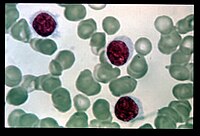
Photo from wikipedia
Plasma cell leukaemia (PCL) is an aggressive haematological malignancy which is classified into primary (pPCL) and secondary PCL. A 39-year-old Indian man presented to the Department of Hematology with a… Click to show full abstract
Plasma cell leukaemia (PCL) is an aggressive haematological malignancy which is classified into primary (pPCL) and secondary PCL. A 39-year-old Indian man presented to the Department of Hematology with a 2-week history of fever and lethargy. Clinically, he was pale and febrile. Haemogram revealed bicytopenia with leucocytosis. The peripheral blood film portrayed rouleax formation with 45% of circulating plasma cells. Serum protein electrophoresis and immunofixation revealed IgG lambda paraproteinaemia of 48 g/L. Bone marrow aspirate, flow cytometry and trephine were consistent with IgG lambda pPCL. He was treated with six cycles of bortezomib, thalidomide and dexamethasone combination chemotherapy followed by high-dose melphalan conditioning and autologous stem cell transplant. Currently, he is in complete remission for the past 18 months and is on oral lenalidomide maintenance therapy. Prognosis is often dismal in pPCL with the median overall survival below 1 year if treatment is delayed.
Journal Title: BMJ Case Reports
Year Published: 2020
Link to full text (if available)
Share on Social Media: Sign Up to like & get
recommendations!